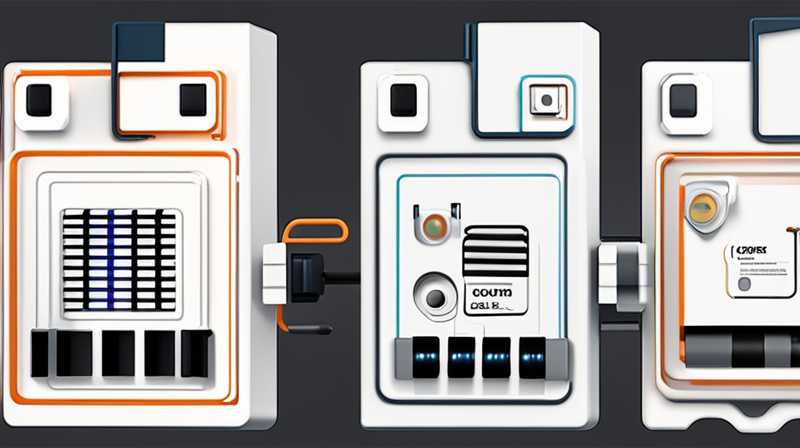
1. The wires commonly used to connect a solar solenoid valve include low-voltage wires suitable for outdoor applications, which can handle the necessary voltage and current without significant loss. 2. These wires must be weather-resistant to endure exposure to various environmental conditions, ensuring long-term functionality. 3. Typical types include stranded copper wires or specific multistranded cables designed for outdoor exposure. 4. The gauge of the wire should align with the current required by the solenoid valve to prevent overheating or electrical failure. A detailed consideration of these aspects ensures the efficacy and reliability of the solar irrigation system, enhancing its operational efficiency while minimizing maintenance issues.
1. UNDERSTANDING SOLENOID VALVES
Solar solenoid valves play a crucial role in irrigation systems powered by renewable energy. These devices regulate the flow of water in automated systems. The functionality of these valves is intrinsically linked to the proper connection established through suitable wiring. Wires act as the conduits for electrical signals that activate or deactivate the solenoid valve, which in turn controls the water flow.
The specifications of the wires chosen impact the system’s efficiency. Wires must be capable of delivering the requisite power from the solar panel to the solenoid valve without experiencing excessive voltage drops. Selecting the appropriate wire gauge based on the current demand and distance between the source and the load is imperative.
2. WIRE TYPES AND SPECIFICATIONS
The wires utilized for solar solenoid valve installations primarily fall into two categories: low-voltage wires and special-purpose cables. Low-voltage wires are often the preferred choice due to their compatibility with garden and irrigation applications, where conventional high-voltage lines are unsuitable. They usually range from 14-gauge to 18-gauge, depending on the specific current requirements of the solenoid valve.
Also, weather-resistant insulation is essential for any wiring scheme involving outdoor components. Wires insulated with materials such as PVC, polyethylene, or silicone provide adequate protection against moisture, UV radiation, and fluctuating temperatures. Such durability results in fewer maintenance issues and longer service life for both the wiring and the solenoid valve system.
3. IMPORTANCE OF WIRE GAUGE
Choosing the correct wire gauge directly affects performance and safety. Using wires that are too thin may cause overheating, leading to insulation failure or electrical fires. Conversely, excessively thick wires may be over-engineered for the application, resulting in unnecessary complexity and cost.
When installing a solar solenoid valve, it’s vital to match the wire gauge with the current draw of the valve. For example, a solenoid valve that requires 1 amp of current may effectively operate with an 18-gauge wire over a short distance, but if the distance increases significantly, a 16-gauge wire may be more appropriate to minimize voltage drop.
4. INSTALLATION CONSIDERATIONS
The installation of wires connecting a solar solenoid valve necessitates careful planning and attention to detail. Adequate planning can prevent future issues stemming from poor connections and improper installations. It is advisable to run wires through appropriately rated conduits to protect them from environmental elements, physical damage, and potential rodent interference.
Proper grounding methods must also be adhered to. Grounding the wiring systems ensures that any excess voltage is safely diverted, significantly reducing the risk of equipment damage and ensuring operator safety. Uniformity in installation procedures plays a critical role in the overall reliability of the solar irrigation system.
5. MAINTENANCE AND TROUBLESHOOTING
Regular maintenance is crucial for ensuring long-term performance of the solar solenoid valve system. Visual inspections can identify wear or damage to the wiring, including cracks, fraying, or corrosion. Any signs of damage should be addressed promptly to avoid possible failure of the solenoid valve operation.
Troubleshooting faulty connections should be methodical. Using a multimeter can help ascertain whether electrical signals are flowing correctly to the solenoid valve. Problems such as a stuck valve or inconsistent water flow can often be traced back to wiring issues, emphasizing the need for systematic checks during maintenance cycles.
FREQUENTLY ASKED QUESTIONS
WHICH WIRE GAUGE IS BEST FOR A SOLAR SOLENOID VALVE?
The ideal wire gauge for a solar solenoid valve largely depends on the specific current requirements and distance of the installation. Generally, an 18-gauge wire can suffice for shorter runs where the current draw remains low, but when distances increase or current requirements rise, opting for a 16-gauge wire is prudent. Calculating the voltage drop is crucial for assuring that the valve receives adequate voltage, as excessive resistance can result in performance issues. For applications exceeding multiple amps, even thicker wire gauges may be necessary to ensure reliability and safety.
ARE THERE WEATHER-PROOF OPTIONS FOR WIRES USED IN OUTDOOR INSTALLATIONS?
Yes, there are numerous weatherproof options available for outdoor wiring installations. Cables designed specifically for outdoor use typically feature insulation made from materials resistant to UV light, moisture, and extreme temperatures. Examples of these include cables insulated with PVC or polyethylene, which withstand a variety of environmental conditions. Utilizing appropriate outdoor-rated cables enhances the longevity of both the wiring and connected devices, thus offering peace of mind for the longevity of solar solenoid valve systems.
HOW DO I TROUBLESHOOT A SOLENOID VALVE THAT WON’T OPEN?
To troubleshoot a solenoid valve that fails to open, start by checking power supply connections. Verify that the solar panel is functioning and that voltage is reaching the solenoid valve adequately. It’s essential to inspect the wiring for any signs of wear or damage while ensuring all connections are secure. Employing a multimeter can help diagnose whether the valve itself is receiving the appropriate signals. A malfunctioning solenoid could also be stuck due to debris or buildup, thus requiring physical inspection and potentially disassembly for cleaning.
In summary, the choice of wiring is essential in the effective operation of solar solenoid valves, including their selection, installation, maintenance, and troubleshooting. Understanding these factors leads to enhanced performance, ensuring that irrigation systems operate seamlessly in a sustainable manner.
Original article by NenPower, If reposted, please credit the source: https://nenpower.com/blog/what-wires-are-used-to-connect-the-solar-solenoid-valve/


